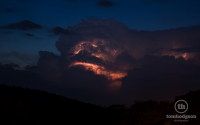Richard Williams
EF0
Hi everyone,
Last year in the UK, on July 1st we experienced a "Spanish Plume" scenario involving record high temperatures and some severe thunderstorms which broke out in the of England in particular.
In the early stages of the storm, as I watched it, it seemed like a multicell complex but is it possible that a cell within the complex could become a supercell?
The reason I ask is because about 11:00PM one apparently produced 2 inch hailstones and I found a picture of it at about that time, lit up by lighting looking like it could show features of possible supercell structure. I have attached some videos and the picture I'm talking about.
And also it seems odd in the first video that the smaller cell is producing almost all the lightning and not the bigger one to the right.
All the vids/pics are of the same storm which was seen for miles around.
Video 1:
Video 2:
Picture of the cell close up at about 11:30PM.

Do you think this cell could have the visual indicators of a supercell?
Last year in the UK, on July 1st we experienced a "Spanish Plume" scenario involving record high temperatures and some severe thunderstorms which broke out in the of England in particular.
In the early stages of the storm, as I watched it, it seemed like a multicell complex but is it possible that a cell within the complex could become a supercell?
The reason I ask is because about 11:00PM one apparently produced 2 inch hailstones and I found a picture of it at about that time, lit up by lighting looking like it could show features of possible supercell structure. I have attached some videos and the picture I'm talking about.
And also it seems odd in the first video that the smaller cell is producing almost all the lightning and not the bigger one to the right.
All the vids/pics are of the same storm which was seen for miles around.
Video 1:
Video 2:
Picture of the cell close up at about 11:30PM.

Do you think this cell could have the visual indicators of a supercell?

